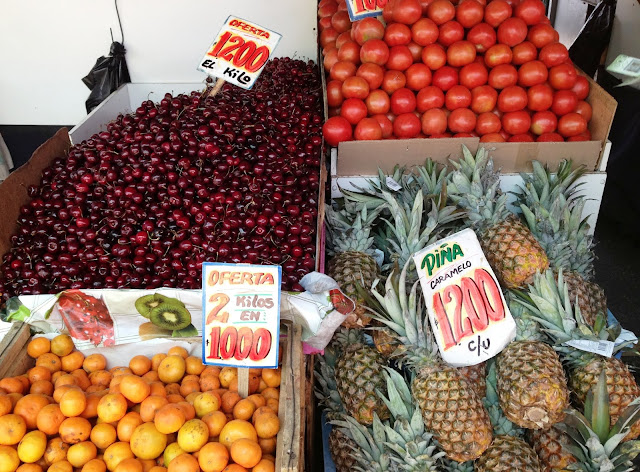Chile's capital city is a bustling metropolis, a modern Southern hemisphere hub featuring the juxtaposition of an ancient, dramatic mountainscape alongside glass-and-steel skyscrapers. The modern and efficient city planning leaves room for lots of wonderful green space as well. This is fitting for the city that represents this South American nation on the Pacific coast -- one that boasts a bounty of agricultural wonders and an amazing assortment of seafood to fill a grand market space like the Mercado Central in Santiago. The market's neoclassical structure was inaugurated in 1872, and is today a protected Historical Monument of the city.
This vast covered market offers food sellers of all stripes, but is overwhelmingly known as the fish market for its exhaustive selection of Pacific "fruits of the sea". There are all kinds of fish in the categories of white flaky fish, there are darker-fleshed oily fish high in Omega 3s. And you can find every kind of shellfish and cephalopod imaginable in this market. Just be careful to keep an eye on where you're walking, as the market floor tends to get a bit hazardous from the constant hosing-down of the seafood stalls. (It would be no fun landing in a puddle of seafood-scented saline sludge!)
One item that I'd never seen in any market before, in all of my travels, was the Pacific giant squid. In the photo here, those crab claws are not baby-sized. They're normal-to-large as far as crab claws go (another local treat). Those rectangular-shaped pieces of what are calamari steaks are essentially sliced rings of the giant squid. They're enormous! The squid are monstrous in size and can grow to be as large as 45 feet long and weigh as much as 600 pounds! These squid sold here may not technically be THE giant squid, but they're really large and are at the very least related to them. And despite what you might think about these large creatures -- my initial thought was that they may be incredibly tough or rubbery when cooked -- they're actually delicious and tender.
No market would be complete without meat for the landlubbers among us. Chile is more of a seafood nation compared to its beef-consuming neighbor, Argentina. But there are still plenty of carnivorous Chileans keeping the meat markets frenetic and literally filled to the rim (of the refrigerator cases) with the king of meats in these parts: beef. The stalls I checked out had impressive displays of all types of bovine cuts, and they were all ruby-red and seemed to be as fresh as they were plentiful.
The Mercado Central of course has lots of fruit and vegetable vendors inside and outside of the market building. When I was there, stone fruits and tropical fruits alike were flooding the bins at the mercado. Gorgeous, brilliantly-colored cherries and tomatoes sat next to pineapples and mandarins.
I was probably most impressed, however, by two items, not only because of their outrageously good flavor everywhere I ate them while dining out, but also because they were so inexpensive while being so flavorful: avocados (paltas in Chilean Spanish) and strawberries -- big, juicy, magenta strawberries called frutillas in Chilean Spanish. I consumed both in whatever form I could, wherever and whenever I could.
Besides boasting all of the magnificent market stalls in the Mercado Central, the market is also home to 22 restaurants within the market space where shoppers can dine on -- what else? -- market-fresh foods ranging from snacks and fruity drinks to multi-course seafood and meat feasts.
It was here that I finally got to indulge in the local dish that Pablo Neruda made famous: Caldillo de Congrio, or conger eel stew. He actually wrote a poem called Oda al Caldillo de Congrio! I must admit, it was tasty enough to make anyone wax poetic.
What else? well, the palmito salad was pretty much worth the price of admission as well. It's a common ingredient in these parts of South America, but in the U.S. it's rare to find a hearts of palm salad.

Another treat for all the other seafood lovers out there: scallops pil-pil. These are succulent medium-sized scallops with the roe sacks still attached, sautéed in a generous amount of garlic-and herb-infused butter and olive oil. This, people, is why we prepare good seafood simply. Period.
So, when heading to Santiago's Mercado Central, you can shop for a little while, and then be sure to time it so you can check out the teeny but charming restaurants around the perimeter of the market building. Try to go for authentic, less touristy-looking places. You will be rewarded with delicious food, cooked to order, so you have a full belly to go along with your full shopping bags.
MERCADO CENTRAL San Pablo 967, Santiago
Sunday - Thursday 6 am - 5 pm
Friday 6 am - 8 pm
Saturday 6 am - 6 pm
https://www.mercadocentral.cl/










No comments:
Post a Comment